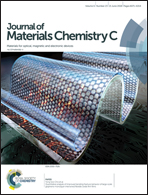Boosting the electroluminescence efficiency of solution-processed thermally activated delayed fluorescence OLEDs with a versatile hole-transporting layer of organic–inorganic hybrid perovskite†
Abstract
An organic–inorganic hybrid perovskite (OIHP), namely CzEAP, containing a large organic ammonium, 2-(9H-carbazol-9-yl)ethanaminium bromide, was synthesized and exhibited a large band gap of 3.5 eV, a maximum valence band energy level of −6.6 eV, and moderate hole mobility comparable to organic hole-transporting materials. Employing CzEAP as a hole-transporting layer (HTL) in solution-processed organic light-emitting diodes (OLEDs) based on a typical thermally activated delayed fluorescence (TADF) emitter, 2,4,5,6-tetrakis(carbazol-9-yl)-1,3-dicyanobenzene (4CzIPN), resulted in a peak external quantum efficiency of 15.3%, which is nearly two times higher than that of a reference device with a PEDOT:PSS hole injection layer alone. The origin of this significant improvement was found to be the versatile functionality of the CzEAP as the HTL, which is for suppressing exciton quenching, improving the emission efficiency and promoting the reverse intersystem crossing (RISC) rate of TADF emitters via the external heavy-atom effect. This finding unlocks the great potential of OIHPs as excellent HTL materials for high-efficiency solution-processed TADF OLEDs.



 Please wait while we load your content...
Please wait while we load your content...